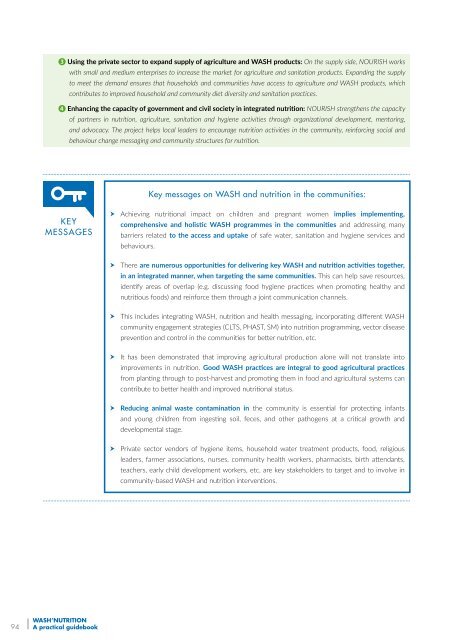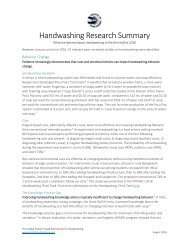WASH’ Nutrition
manuel_wash_nutrition_online
manuel_wash_nutrition_online
Create successful ePaper yourself
Turn your PDF publications into a flip-book with our unique Google optimized e-Paper software.
3 Using the private sector to expand supply of agriculture and WASH products: On the supply side, NOURISH works<br />
with small and medium enterprises to increase the market for agriculture and sanitation products. Expanding the supply<br />
to meet the demand ensures that households and communities have access to agriculture and WASH products, which<br />
contributes to improved household and community diet diversity and sanitation practices.<br />
4 Enhancing the capacity of government and civil society in integrated nutrition: NOURISH strengthens the capacity<br />
of partners in nutrition, agriculture, sanitation and hygiene activities through organizational development, mentoring,<br />
and advocacy. The project helps local leaders to encourage nutrition activities in the community, reinforcing social and<br />
behaviour change messaging and community structures for nutrition.<br />
Key messages on WASH and nutrition in the communities:<br />
KEY<br />
MESSAGES<br />
Achieving nutritional impact on children and pregnant women implies implementing,<br />
comprehensive and holistic WASH programmes in the communities and addressing many<br />
barriers related to the access and uptake of safe water, sanitation and hygiene services and<br />
behaviours.<br />
There are numerous opportunities for delivering key WASH and nutrition activities together,<br />
in an integrated manner, when targeting the same communities. This can help save resources,<br />
identify areas of overlap (e.g. discussing food hygiene practices when promoting healthy and<br />
nutritious foods) and reinforce them through a joint communication channels.<br />
This includes integrating WASH, nutrition and health messaging, incorporating different WASH<br />
community engagement strategies (CLTS, PHAST, SM) into nutrition programming, vector disease<br />
prevention and control in the communities for better nutrition, etc.<br />
It has been demonstrated that improving agricultural production alone will not translate into<br />
improvements in nutrition. Good WASH practices are integral to good agricultural practices<br />
from planting through to post-harvest and promoting them in food and agricultural systems can<br />
contribute to better health and improved nutritional status.<br />
Reducing animal waste contamination in the community is essential for protecting infants<br />
and young children from ingesting soil, feces, and other pathogens at a critical growth and<br />
developmental stage.<br />
Private sector vendors of hygiene items, household water treatment products, food, religious<br />
leaders, farmer associations, nurses, community health workers, pharmacists, birth attendants,<br />
teachers, early child development workers, etc. are key stakeholders to target and to involve in<br />
community-based WASH and nutrition interventions.<br />
94<br />
<strong>WASH’</strong><strong>Nutrition</strong><br />
A practical guidebook



